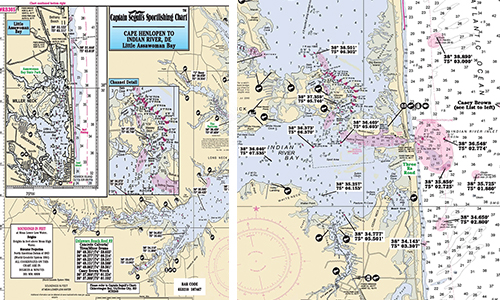INDIAN RIVER INLET, DE

SUMMER FLOUNDER
While the best of the flounder fishing here may be over, there will be some real doormats landed by those who drift live spot or jig with bucktails. Usually, those fish are taken by anglers trying for rockfish, but a directed fishery could begin early in the month before the best of the striped bass run begins.
Drifting along the north side between the Green Can and the entrance to Indian River Inlet Marina or along the south side from the end of the campground to the entrance to South Shore Marina will be the best technique for connecting with a big flounder. Flounder will also be taken from the rock jetties on either side of the inlet and from Bubblegum Beach accessed through Indian River Inlet Marina.
Live bait works in these locations as well, but a more practical approach is casting bucktails. (Keep in mind there’s no closed season on summer flounder in Delaware, with 16-inch minimum size and four per angler limit in 2016.)
ROCKFISH (STRIPED BASS)
These are the fish that get everyone’s heart rate up. They begin to arrive early in the month peaking towards the end of the month and often lasting past Thanksgiving. Jetty jockeys will be in their glory casting bucktails, plugs and the always popular and effective live eels from the rocks. This is the night shift and they usually have the first of the migrating stock.
The day shift works from boats drifting live spot or casting bucktails. The number one lure is a white bucktail with a white plastic or Gulp! worm. The drift is almost always better on incoming water and the top time is daybreak or dusk.
There is a rip just inshore of the bridge across from the Coast Guard Station that can be very productive. It used to run all the way back to the entrance to South Shore Marina, but since the Corps of Engineers dredged out the inlet this structure is not as strong as it once was.
Drift with the current while tossing a bucktail ahead of your boat and allow it to sink before using a slow retrieve. That is the best method for working this rip. Keep working the jig until it is at the boat; I have on more than one occasion had a take just before raising the bucktail out of the water.
Another technique that works here is trolling with Stretch 25s. Actually trolling is a bit misleading; successful anglers stem the incoming current by holding their boat in place while the plug works back in the rip. This is not going to make you very popular with the vast majority of your fellow and anglers who are drifting and casting bucktails, so trolling is best done when not may others are fishing here and that is usually in the pre-dawn hours.
Live bait fishing is very effective after large striped bass have arrived. As this is written live spot are going for $2.50 each and that is before the stripers have made an appearance. I have seen short rock and blues take one live spot after another and that can get really deep into someone’s fishing budget. Save some cash or keep your live box full of spot until some fish worthy of the expense make a showing.
BLUEFISH
Delaware has seen some big blues along the coast and at the inlet over the past two years. As we all know, previous performance is no guarantee of future results so perhaps we will see them this fall or maybe not. I am pretty sure we will see smaller versions of bluefish because these fish have been abundant here all summer.
The only difference between a big blue and small blue is the size of the lure. When the big boys are around I use a big Hopkins No=Equal and drop down to the smallest model for the little guys. Truth be told, when blues are tearing up bait at the inlet just about anything that shines is going to work, but Hopkins Lures cast like a bullet, have enticing action on the fall and the retrieve and won’t come apart in a blue’s mouth.
TAUTOG
Tautog season reopens in Delaware on September 29 and runs until December 31 with a 15-inch minimum size and a five-fish bag limit. This is one of the more popular species for those who fish the jetty with bait. They use green crabs or sand fleas and sit for hours waiting for a tog to come along.
This fishing gets better as the water gets colder making it the last hooray of the year.
Chart courtesy of Captain Segull’s Charts. For more details, please refer to Captain Segull’s Sportfishing Chart RB305, Rehoboth Bay Indian River Bay. Visit www.captainsegullcharts.com.

